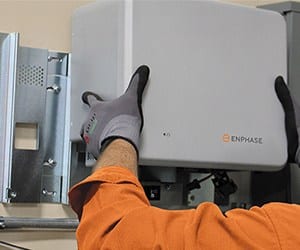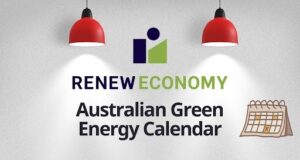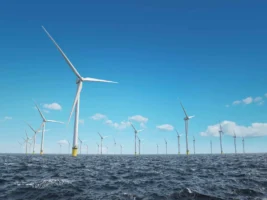Just over six months after the first batch of Tesla Powerwalls went into Australian homes, major Tesla rival, Enphase Energy, has installed its first battery storage beta system at an installer’s house in Sydney, as part of a final phase of testing of the US-made technology before mass market rollout.
The Enphase Storage System, installed at the family home of Solaray Energy director Peter Thorne, includes four 1.2kWh AC batteries, which will store the excess solar energy generated by the house’s existing 5kW rooftop PV system.

“The installation was incredibly easy,” Thorne said in a statement on Thursday. “There were no modifications needed to my existing system as the… batteries are compatible with my existing Enphase-powered solar system, and they look great in my garage.”

Enphase says one of the major benefits of its battery system is that it can be cycled twice a day, which means consumers can also buy and store power from the grid when it is cheapest, to use when the price is high.
“This is a key feature that many households with time-of-use billing will benefit from, and it effectively doubles a battery’s daily capacity,” Enphase said in a statement on Thursday.
Another advantage of the technology, according to Enphase, is that the batteries are AC, making them “inherently safer” than DC batteries, easier to install, and compatible with all existing solar installations.
Also, the small, modular design of the Enphase AC Battery allows households to size the systems accordingly, and to avoid overspending on storage capacity – or to add more capacity, later, if the need arises.
Thorne said the battery system installed at his house had allowed it to run almost entirely off solar power.
“I now see the power grid as nothing more than a backup, and that’s where I think we need to get to as a nation over the coming years,” he said.
“Because my partner and I are both at work during the day, battery storage allows us to catch any excess power we would otherwise be reluctantly giving away to our energy retailer at 5 cents a kWh.
“We would much rather see this power stored in batteries so that we can further reduce our power bills by using it when we come home from work.”
Solaray Energy director Jonathan Fisk the company had seen huge interest in the Enphase battery product, and that “months’ worth of installation slots” had already sold out.
“It is an incredible time for the industry,” Fisk said in a statement. “We are expecting the Enphase Home Energy Solution to be a top seller in Australia throughout 2016 and well into the future.”
Indeed, Enphase, like Tesla, has made Australia the first international market for the rollout of its energy storage products, lured by the attractive combination of high electricity prices and low solar feed-in tariffs.
It’s a strategy that appears to be paying off: In May, Enphase said orders for its battery storage products were running at double the targets, indicating huge interest in the “early adopter” market.
And in June, the company doubled its battery production targets in Australia, in response to the level of demand, from 12,000 and 15,000 units in the next six months and the following six months, to a total of 60,000 units for the 2016/17 financial year. That equates to around 70MWh.
“I believe millions of Australians will look at converting their homes to run off solar power given how easy it is to add batteries,” Thorne said.










